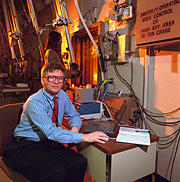- Number 295 |
- September 14, 2009
Chuck Coleman: Unique methods for a unique facility

Chuck Coleman
The space where you are likely to find Dr. Chuck Coleman of the Savannah River National Laboratory looks vaguely mysterious. Here, in SRNL’s Shielded Cells facility, skilled operators stand on one side of heavy glass shielding, using long-armed manipulators to work with highly radioactive samples on the other side. These multi-purpose shielded cells provide a safe environment to conduct examination, testing, analysis, and lab scale demonstrations in support of Environmental Management work at Savannah River site and other customers. Using methods Dr. Coleman developed for use in this unique facility, analyses conducted in these cells have provided vital information for the treatment and disposal of high-level radioactive waste from both the Savannah River and Hanford sites. As an expert in analytical chemistry applied to radioactive waste and nuclear technology, Dr. Coleman for 25 years has been instrumental in designing analytical methods for use in the cells.
Dr. Coleman first became involved with shielded cell analytical work in 1984 in his role as the principal method development chemist for the Defense Waste Processing Facility that immobilizes high-level nuclear waste in glass logs at the Savannah River Site. He also served as analytical consultant to the West Valley, NY, Demonstration Project and the Hanford Waste Treatment and Immobilization Plant now under construction near Richland, Washington. “I am pleased that I had the opportunity to assist the analytical chemistry effort in all three of the U.S. high-level waste vitrification plants” says Dr. Coleman. His work has resolved important analytical chemistry issues affecting major radioactive waste operations, and one project for the Hanford Waste Treatment Project met a challenge that many felt was unattainable: developing analytical schemes that could meet a 9-hour turnaround time for process control samples. His work with radioactive waste led to his leadership of other shielded cell facility initiatives, including a project to demonstrate use of the cells in analysis of simulated “dirty bomb” samples for homeland security-related work.
“Because of their safeguards, these cells are really the only place to conduct analysis of highly radioactive materials,” he says. “That makes it exciting, knowing that we are making a unique contribution.” Dr. Coleman is currently leading a team whose goal is to streamline the sampling and analytical methods to support the increased production rates of the Defense Waste Processing Facility.
The methods he develops take into account not just the analytical needs, but also the human factors associated with doing work with manipulators behind shielding. “The key to methods for use in the cells is keeping it simple, since everything has to be done with manipulators,” he adds. “I’m always looking for the method that gets results in three steps, rather than 10.”
Submitted by DOE's Savannah River National Laboratory
